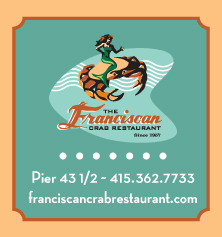Fort Mason Center welcomes new executive director Rich Hillis
Combining the quick wit and wry sense of humor required for a stint in late-night television with a zeal for improving the quality of life in San Francisco, Hillis brings extensive experience to his new job.
The road leading to Fort Mason Center was a circuitous one for Hillis, who is succeeding Ann Lazarus as executive director of the former military base that now houses approximately two dozen nonprofit agencies serving not only the Marina but all of the San Francisco Bay Area. Having graduated summa cum laude from the State University of New York in Albany with a B.A. in accounting, Hillis decided to come to San Francisco, driving across country with all of his possessions. After an overnight stop in Albuquerque, he woke up, went out to the parking lot of the motel, and found his car and all of those possessions gone.
Not to be dismayed, he retraced his steps and ultimately landed in Chicago, where he earned his master’s degree in public policy analysis at the University of Chicago. After graduation, he responded to Letterman’s on-air call for interns; he submitted his application and was hired to research upcoming guests. He also suggested possible questions and topics for the comic, and, in his words, acted as “water boy for big-shot Hollywood celebrities.”
Hillis set out again for San Francisco with no mishaps along the way. He began work at Wells Fargo Bank as a corporate tax analyst, then returned east and worked at Arthur Andersen & Co. in Washington, D.C. as a senior tax consultant, followed by two years as special assistant for fiscal affairs in the Office of the City Administrator, District of Columbia Government in Washington, D.C.
Finally, in 1995, Hillis returned to San Francisco to stay. From 1995 until last month, he worked in San Francisco’s Office of the Mayor. During Mayor Frank Jordan’s administration, he served as senior analyst in the Office of Finance and Legislative Affairs, where he negotiated with employee unions and studied and implemented new municipal parking garage rates and new hotel tax legislation.
In the Jordan, Willie Brown, Gavin Newsom, and Ed Lee administrations, Hillis was responsible for the management of complex public and private real estate and economic development projects. His duties included overseeing all aspects of the redevelopment of Treasure Island and Yerba Buena Island; he led the city team in the $1.5 billion project in which he dealt with the Board of Supervisors, the media, and with multiple federal, state and local agencies.
He also worked on port development plans, mid-Market redevelopment, Recreation and Park projects, and business partnerships including the annual Outside Lands concerts and expansion of the San Francisco Museum of Modern Art.
Hillis’s achievements extend beyond those listed here. South of Market resident Lynn Valente recalled the challenges facing the Octavia Boulevard/Central Freeway Development team in creating and implementing a comprehensive strategy for the disposition and development of 22 former-freeway parcels and the reconstruction of Octavia Boulevard. Hillis led the team.
“Our neighborhood was devastated and angry when the Central Freeway ramp was torn down and then rebuilt over our streets a year later. Rich heard us when no one else did. … We were able to get more than $6 million dollars for street improvements and community amenities for our neighborhood. We could not have achieved this without his expertise,” Valente said.
Neighborhood, in fact, is a key factor in Hillis’s plans and goals for Fort Mason Center.
“Fort Mason Center is a vibrant part of our community and has touched everyone in some way,” Hillis said. “Residents [the Fort Mason Center tenants], the immediate neighbors along Marina Boulevard, the Marina District population, and, in fact, San Francisco and the entire Bay Area are attracted to Fort Mason by events held here, by Crissy Field, and by programs and activities offered to people of all ages and interests,” Hillis said. He already is working with the National Park Service (NPS) and the city of San Francisco on the possible extension of the historic F-Line streetcar to draw more visitors.
High on his to-do list is improving the look of the entrance to Fort Mason Center.
“Fort Mason is a national historic landmark, a nonprofit partner of the National Park Service. We are stewards of this historic military base for the NPS and I think everything about the buildings should reflect its importance,” Hillis said.
He cites Pier 1 within the center as an example of improvements he intends to make.
“For 30 years Pier 1 has been used for storage. This should be an active space,” he said.
In addition, Fort Mason Center has acquired the operation of two major spaces in Upper Fort Mason: the general’s residence, also known as the former officers’ club, and the chapel. Hillis cites both buildings as needing renovation. Headquarters for the NPS is housed in Upper Fort Mason, as is an event space, the use of which Hillis hopes to see increased.
“We want to do in the next 30 years what has been done in the past 30 years,” Hillis said.
Such improvements require major dollars. Currently, Fort Mason is in the midst of a capital campaign to rehab Cowell Theater and Herbst Pavilion, the oldest structures on campus, as well as some of the other historic buildings. Other sources of revenue include fundraising, existing Fort Mason funds, tax credits, reserves, grants, and bank loans.
“The search for an executive director with the background, vision and drive to take Fort Mason Center forward was extensive. We are confident that we have found the perfect leader in Rich Hillis,” said Judith Glickman, chairwoman of the board of directors.
This former “water boy for big-shot Hollywood celebrities” has certainly come a long way.


